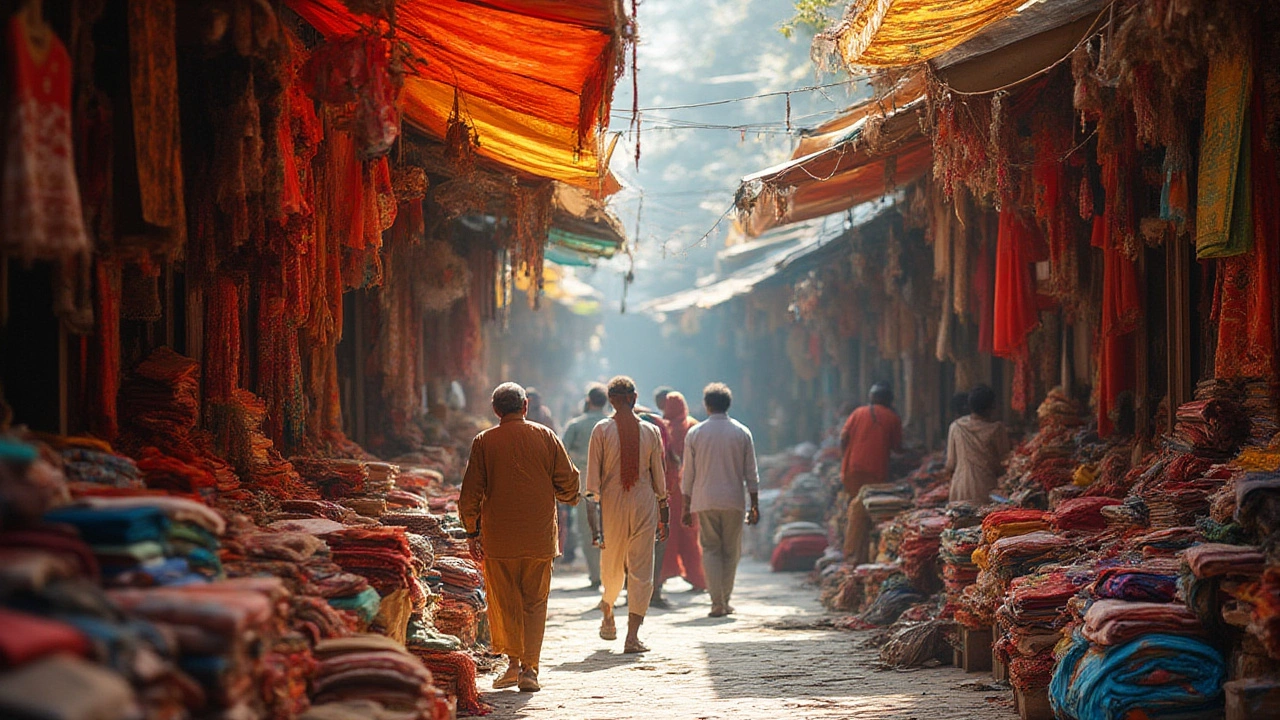Picture this: You’re hunting the globe for the world’s best wholesale fabric, and you want to know how to get top-notch material without breaking the bank. You’re hoping to sidestep the fakes, get real value, and find vendors you can trust. If you think it’s as easy as googling “cheap fabric,” you’re in for a wild ride. The wholesale textile market is huge, messy, and full of surprises—even veteran buyers have stories of good finds and nightmare deals. If you want the real answer to which country is best for wholesale fabric, it’s not as simple as picking the biggest flag on the map. Because the so-called “best” depends on what you’re after: cost, quality, consistency, eco-friendliness, speed, or pure variety.
Let’s dig into global textile giants, see what makes them tick, and learn how buyers—big brands, tiny shops, or ambitious start-ups—really source wholesale fabric for the modern market.
Why Wholesale Fabric Matters and What Makes a Top Supplier?
The global fabric scene moves quick. Fashion turns on a dime, sportswear tech is always one design ahead, and home décor trends come and go with the seasons. Wholesale fabric suppliers decide so much more than just price. They shape whether your business gets popular with customers, or flops with off-trend inventory that sits in storage. That’s why sourcing matters way more than it seems.
But what makes a country stand out as the “best” for wholesale fabric? You can break it down like this:
- Range and variety: Some countries are known for luxury silks, others for rugged canvas, or super-soft knits. If you want it all, only a few nations deliver.
- Cost: Naturally, price per metre or yard is king, especially for businesses running tight margins. But cheap doesn’t always mean better.
- Quality and reliability: International buyers know there’s a world of difference between what’s advertised and what actually gets delivered. Consistency is gold.
- Speed and shipping: Lead times can kill a business. Being able to get the right fabric in days instead of months is a game-changer.
- Certifications and ethics: Eco-friendly and fair-labour standards really matter—a growing number of brands refuse to risk a scandal for savings.
Here’s the real kicker: No single country can tick every box for every use-case. Some excel in certain fabrics or processes, while others offer killer prices for commodity goods. Most of the world’s fabric actually comes from just a few places, though, so let’s break those down one by one.
The Top Wholesale Fabric Countries: What’s Each One Famous For?
Think “fabric powerhouses” and you’re probably picturing China, India, Turkey, Bangladesh, Vietnam—or maybe Italy for the luxe stuff. Here’s what each country is actually best known for and who it’s best for:
China: The world’s biggest source of wholesale fabric—by far. Factories in Zhejiang, Jiangsu, and Guangdong churn out hundreds of billions of dollars’ worth each year. China shines if you want choice, unbeatable scale, and prices that are hard to match. Polyester, cotton, viscose, denim, jersey, lace, silk... you name it, someone in China can deliver it by container load. But beware: with thousands of trading companies and factories, quality varies. Big buyers visit in person, inspect samples, or use third-party agencies to avoid poor-quality batches or shipping headaches.
| Country | Fabric Strengths | Annual Export Value (USD, 2023) | Typical Lead Time |
|---|---|---|---|
| China | Polyester, cotton, denim, silk, synthetics | $150 billion+ | 2-6 weeks (sea) |
| India | Cotton, silk, artisan prints, handloom | $43 billion | 2-8 weeks |
| Turkey | Fashion fabrics, knits, denim, eco-certified | $12 billion | 1-3 weeks |
| Bangladesh | Ready-to-sew fabrics, high volume | $10 billion | 3-6 weeks |
| Italy | Luxury, wool, linen, silk blends | $9 billion | 1-2 weeks (air) |
India: If you’re obsessed with natural fibres, block-printed cottons, or stunning artisanal silks, India is your playground. Their legacy is deep: vibrant, colourful, hand-printed and handwoven fabrics that upscale designers and sustainable brands swear by. India is also strong in export-ready, mill-made cotton and viscose, often at prices undercutting Europe. The go-to markets? Surat for synthetics, Tiruppur for knits, and Bhilwara for suitings. Plus, India has some of the world’s highest volumes of organic cotton. One thing to watch: always clarify specs, since fabric thickness (‘GSM’), shrinkage, and dyefastness vary. Ask for lab reports—and build relationships with your mill or trader.
Turkey: Here’s a country that’s nailed the "fast fashion" model for Europe thanks to its location. Turkish textile factories pump out high-quality knits, denims, and sustainable jersey at lightning speed—often with European eco standards, like OEKO-TEX or GOTS. Prices aren’t always as low as Asia, but Turkish fabrics fly to Britain, Germany, or France in a fraction of the time. Istanbul’s wholesale markets are famous across the EU for good reason. For buyers who need both quality and quick response, it’s hard to do better.
Bangladesh: You’ve seen the labels—"Made in Bangladesh" is everywhere. Their main edge? Mass production volumes and well-organised supply chains, especially for ready-to-sew fabrics for the clothing industry. The country pushes out tons of cotton, polyester blends, and knitwear. Costs stay low thanks to skilled workers and giant mills like BEXIMCO and Square Textiles. However, for brands concerned with sustainability or worker safety, stick to suppliers with strong certifications and transparent audits.
Italy: Say the word "Prato" or "Como" to a fabric lover and watch their eyes light up. Italy produces the world’s most desirable luxury fabric—wools, silks, premium linens, and insanely technical blends that fashion designers line up to buy. The price is premium, of course, but for certain high-end or bespoke products, buyers simply won’t settle for less. Many Italian suppliers still work with family-run mills, using skills tuned over generations. Shipping is fast inside Europe, but minimum order quantities (MOQs) can be lower than big Asian mills.
Now, these aren’t the only major players. Vietnam is climbing fast with synthetic and sports textiles. Pakistan is a powerhouse for towels, cotton, and home textiles. South Korea serves up unbeatable polyester and techwear fabrics. You just need to match the country to your niche.

How to Choose Your Best Wholesale Fabric Country
Makes sense so far, right? But say you need 10,000 metres of printed jersey for a fast fashion line—do you go with China or Turkey? Or you want custom block-printed scarves for an eco boutique—should you focus on India or seek out Italian silk?
Here’s a checklist to cut through the global noise and get exactly what you need:
- 1. Know your buyer: Are your customers looking for ethical and eco-friendly clothing? Go with India or Turkey, where you can get GOTS-certified fabrics and artisan goods. Do they want bargain prices? China or Bangladesh could be better.
- 2. Budget vs. timeline: If your project has a tight drop date, Turkey’s fast logistics can be a lifesaver for European buyers. If you have months and want the comfort of budget rates, China or India fit the bill—just plan for shipping and customs lag.
- 3. Minimum Orders & Flexibility: Some suppliers only want to deal with big fish—tens of thousands of metres a go. Others happily ship a few hundred for smaller runs. Italy, Turkey, and Korea tend to be more flexible for low minimums.
- 4. Certifications and audits: This is huge now. Ask for OEKO-TEX, GOTS, Sedex, or WRAP certifications—and don’t just take a PDF. Ask your supplier to send you the certification numbers so you can look them up yourself. No paperwork? Walk away.
- 5. Sampling and communication: Always ask for samples, and check the real fabric before you pull the trigger. WhatsApp, WeChat, Zoom—the days of endless email back-and-forth are over. Great suppliers reply within a day, answer straight, and are clear about payment terms.
You’ll hear stories about “hidden gems” and unbeatable deals. It pays to be skeptical but not cynical—there are brilliant suppliers out there if you know how to look.
Tips for First-Time Wholesale Fabric Sourcing
If you’ve never sourced fabric in bulk, it’s got a thrill—and a risk. Fabric mistakes cost cash, time, and sometimes your reputation. Here’s how smart buyers make it work, even if they’re new:
- Start small: Don’t jump into a 30,000-metre order until you’ve seen quality, reliability, and real shipping times. Test your supplier with a small run first.
- Attend trade shows: Huge textile shows like Intertextile Shanghai, Heimtextil Frankfurt, or India International Textile Expo are great for seeing 1000s of suppliers in days. You can touch the goods, haggle, and build a shortlist fast.
- Visit in person if possible: Even one trip to a country’s textile hub—like Guangzhou (China), Surat (India), or Istanbul (Turkey)—teaches you more than months of emails.
- Check references: Ask suppliers for recent export clients, especially from your country. Brands are often surprisingly willing to chat about their experiences—good or bad.
- Know the lingo: Words matter in fabric. Make sure you’re clear on GSM (grams per square metre), width, shrinkage, dye specs, printing methods, and blended composition. Never assume.
- Watch out for copycats: This is huge in China and India—factories copy styles and may cut corners if you aren’t clear and insistent about your standards.
And always, always confirm terms in writing: prices, lead times, payment steps, delivery, and what happens if stuff arrives damaged.
The global textile trade is cutthroat, but the right partner will make you unstoppable.
If anyone tells you there’s one “best” country for wholesale fabric, they’re missing half the picture. Each top fabric country—China for wholesale fabric scale, India for unique and ethical goods, Turkey for fast fashion, Bangladesh for volume, Italy for luxury—plays a different tune. Your business strategy should be to pick the country that fits your niche, your customers, and your risk level. If you need help with sourcing, don’t be afraid to reach out to local trade chambers, buying agents, or your peers—word of mouth still beats five-star online reviews any day.

